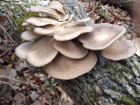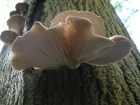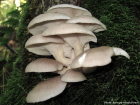Cap convex with an incurved margin at first, expanding to a fan-shaped with a flat or shallowly depressed disc and inner limb. The cap colour is pale to dark brown, fading to buff, sometimes fading slowly and becoming two-toned. It may be somewhat greasy when young and fresh. The flesh is thick, white and unchanging when sliced. Gills running down the stem, crowded, whitish or with a grey tinge, becoming yellowish in age and sometimes developing brownish edges, and descend on the stalk if present. Stem off-centre with a lateral attachment to wood, whitish. It can sometimes be more or less central when growing on the tops of logs or branches. Spore print white to faintly yellowish, or pale lilac-grey.
Microscopic Features: The spores are subcylindrical to narrowly kidney-shaped, smooth, measuring 8-12.5 x 3-4.5µm.
Pleurotus ostreatus on the MushroomExpert.Com Web site.
Pleurotus ostreatus on the www.first-nature.com web site.
Many mushrooms are poisonous, and some can be lethally toxic. Distinguishing between edible and poisonous mushrooms can be very challenging. Therefore, we strongly advise against consuming wild mushrooms. This website does not contain any information about the edibility or toxicity of mushrooms.
Although efforts have been made to ensure accuracy on this website, the information may contain errors and omissions. Therefore, all content provided is for educational and informational purposes only and should not be relied upon or used as a basis for consuming any plants or mushrooms.
External links are provided for reference only. We do not endorse or take responsibility for the content, advice, or products found on these sites or in any advertisements shown on this website.




